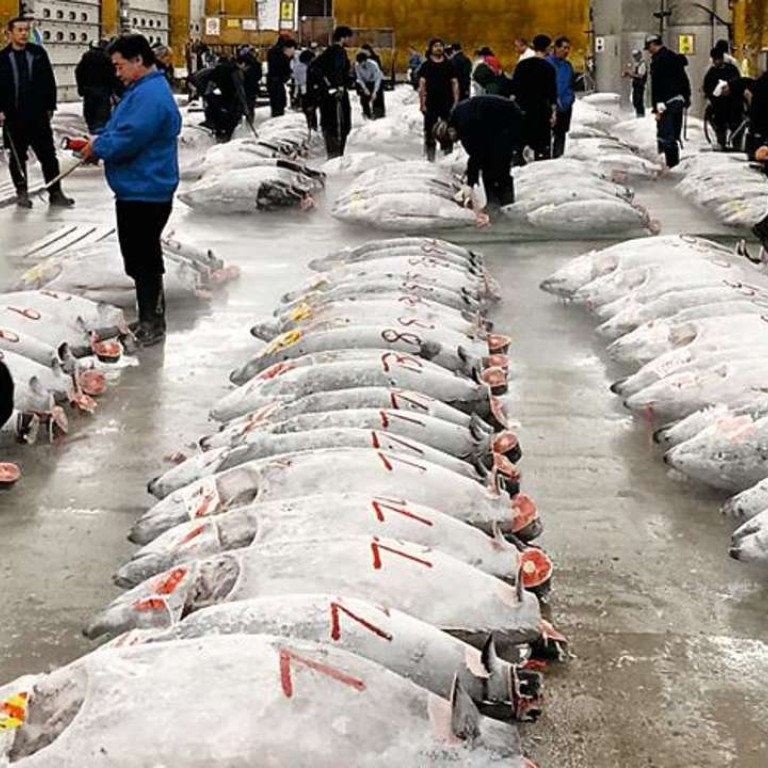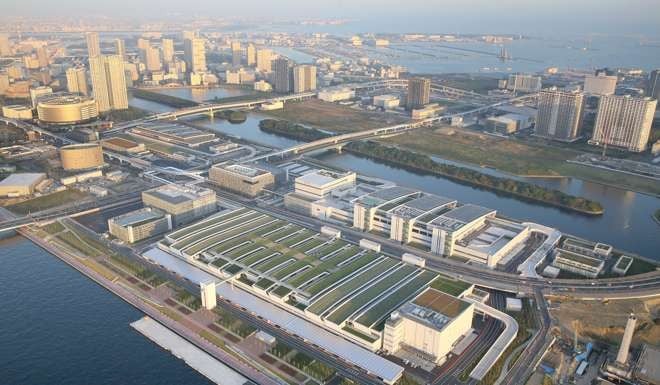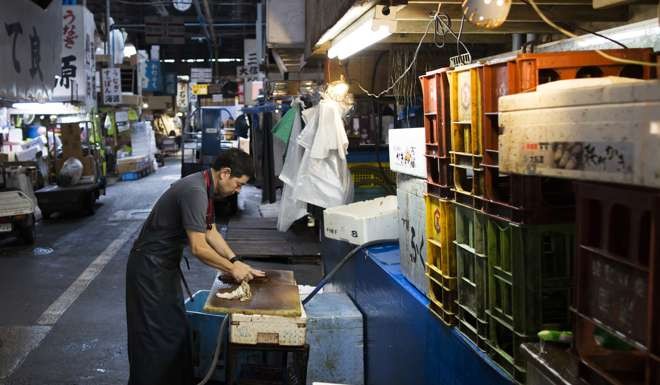
Trouble at Tsukiji: world’s biggest fish market caught in limbo as move stalls
Crisis over famed Tokyo market’s relocation, put on hold because of pollution at its planned new site, hangs over traders as they go about the business of feeding supply line of top-quality fish to restaurants
From extravagantly priced tuna belly sushi to a simple dish of tempura squid tentacles, if you eat seafood in Tokyo it will almost certainly have come from Tsukiji market, a sprawling collection of warehouses, restaurants and shops that has been part of the Japanese capital’s economic and cultural fabric for more than 80 years.

By the time the dawn auctions have ended, 3,000 mostly frozen tuna – their lifeless forms resembling second world war bombs – will have passed through Tsukiji before being sent across Japan. But the fate of the world’s biggest fish market is in the balance after a planned move to new premises was halted due to contamination concerns.

Tsukiji is a draw not just for tuna lovers. The sprawling market, covering 2.4 million sq ft, handles more than 400 varieties of seafood a day with a combined weight of 1,800 tonnes, generating daily sales worth about 1.8 billion yen. It also sells about 270 varieties of fruit imported from around the world.

The Japanese eat more fish per capita than any other developed country, consuming about 27kg annually, in a market worth 1.4 trillion yen, compared with the global average of 19kg. The country’s appetite for bluefin tuna – it consumes 80 per cent of the global supply – has sent stocks of the fish plummeting and sparked warnings that the species is nearing commercial extinction.
While overall seafood consumption declines in Japan, demand from overseas – mainly from China, South Korea and Europe – has seen Japanese fish exports rise dramatically in recent years.
These are uncertain times for Tsukiji and a customer base that now stretches well beyond Japan’s shores. Early this month its workers were supposed to have packed away their knives, said goodbye to their overcrowded, ageing premises and moved to a new building in Toyosu, less than two miles south along Tokyo Bay.
That was until Tokyo’s new governor, Yuriko Koike, put an abrupt halt to the move, citing rising concerns over evidence that the new site – built at a cost of 588 billion yen – was contaminated with dangerous toxins.
It’s got to the point that the situation here is being compared to Fukushima … rumours can destroy businesses
Surveys have revealed levels of benzene, arsenic and cyanide slightly above government-set standards. Mercury levels between five and seven times the national air quality standard were found in the building’s basement.
Koike, a conservative maverick who has criticised her predecessors’ handling of the move, says she will wait until the results of a new environmental survey are published in January before making a final decision.
“Postponing the move puts the citizens of Tokyo first,” Koike told reporters when she announced the postponement.
On a recent morning at Tsukiji, chatter about the market’s biggest crisis since it opened in 1935 mixed with the buzz of bandsaws slicing through bluefin tuna and the hum of motorised carts piled high with boxes filled with everything from live prawns and sea urchins to sea squirts and oysters.
With Tsukiji now an immediately recognisable guarantee of quality among buyers in other parts of Asia, Europe and North America, fears over the safety of the new site are spreading well beyond Tsukiji, according to veteran wholesalers.
“Harmful rumours about the contamination are spreading around the world,” says 68-year-old Susumu Miura. “Safety and reassurance are the two most important factors in our relationship with our customers. It’s got to the point that the situation here is being compared to Fukushima … rumours can destroy businesses.
“Tsukiji only prospers because of its brand, and that brand is based on the absolute guarantee that our produce is safe to eat. Take that away, and the trust evaporates.”
Makoto Nakazawa, a senior official with the Tsukiji market branch of the national confederation of trade unions, says: “The Tokyo government tried to force the move through by lying to us about its decontamination measures. It insisted the site had been cleaned up properly, but it turns out that it wasn’t.”
A poll of Tsukiji wholesalers conducted in April revealed overwhelming opposition to moving to Toyosu. Among the 247 who responded, 205 said they wanted to stay in Tsukiji; only nine said they wanted to relocate.
Some experts say the slightly raised levels of toxic substances do not present a risk to human health.
Kohei Urano, a professor emeritus of environmental safety at Yokohama National University, told the Asahi Shimbun: “As people do not drink the groundwater or wash fish with it, there will be no problem, even if the [pollutant] concentrations exceeded environmental standards.”
The move will destroy the Tsukiji identity, one that is known globally
But market workers say they no longer trust official reassurances. “We deal in fresh fish, and fruit and veg, that’s why I’ve been against the relocation all along,” says Michio Wachi, 71, who has worked at the Komineya tuna wholesaler for almost five decades.
“I don’t think for a moment that governor Koike will allow the relocation to happen. Even if they clean the place up, the toxins below ground could resurface at some point in the future.”
Under the original relocation plan, the outer market, a popular destination for foreign tourists in search of the freshest sushi breakfast imaginable, will be spared the wrecking ball to preserve some of its old charm.
But by moving the wholesalers to new premises in Toyosu, city planners risked ripping the heart out of Tokyo’s proud seafood-selling tradition, said Robbie Swinnerton, a food writer for the Japan Times. “The move will destroy the Tsukiji identity, one that is known globally and which has become a symbol of Japan’s traditional food culture,” he says. “It won’t be the same if the market is gone.”
While Koike and her advisers pore over the latest pollution data, life at Tsukiji carries on in a state of limbo. Now, perhaps more than ever, the thousands of people with a strong emotional, as well as commercial, attachment to Tsukiji will feel the need to turn to the shinto gods at nearby Namiyoke (protection from the waves) shrine for divine intervention.
“The potential loss of atmosphere and charm is horribly sad,” says Yukari Sakamoto , a Tokyo-based chef and food writer who guides foreign tourists around Tsukiji’s maze of narrow alleyways. “My gut says don’t move. But what is the solution? And at what cost?”

